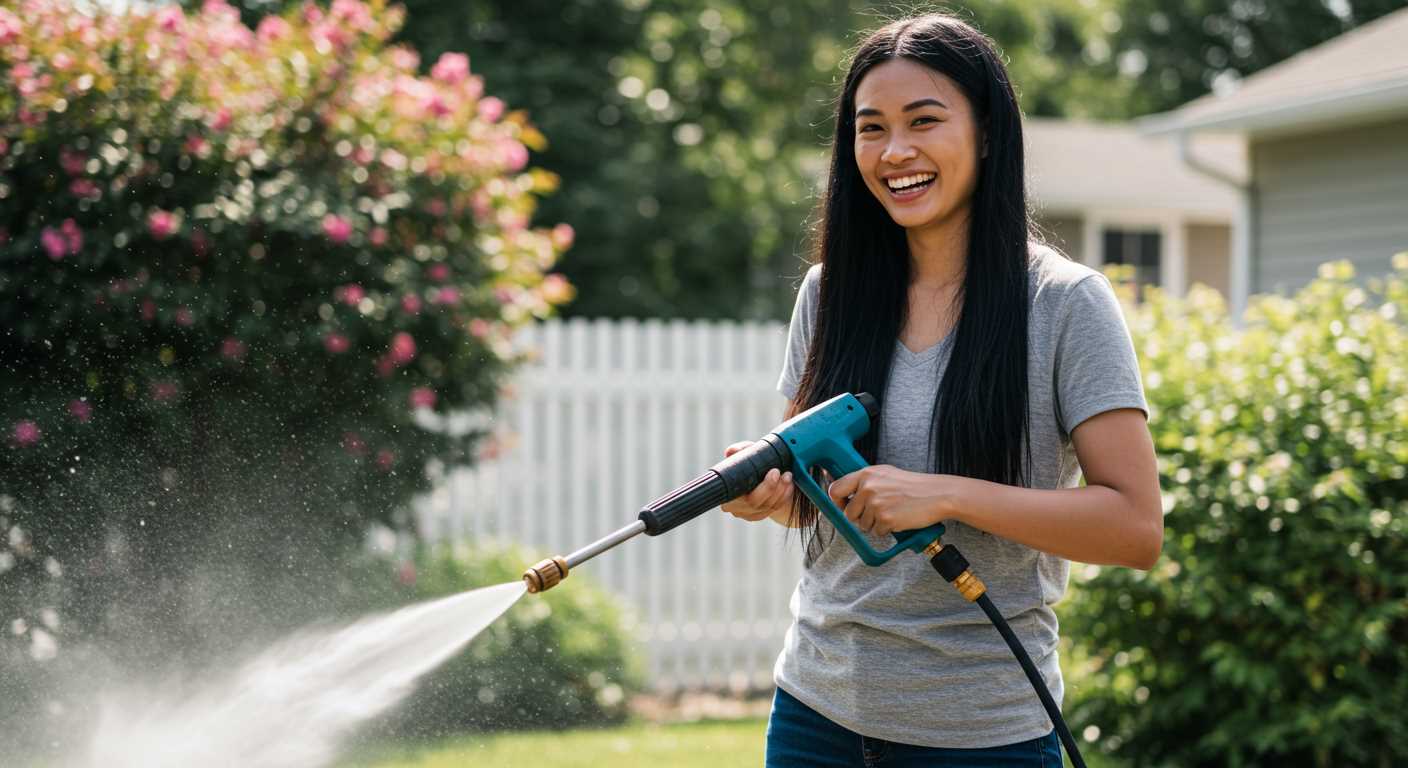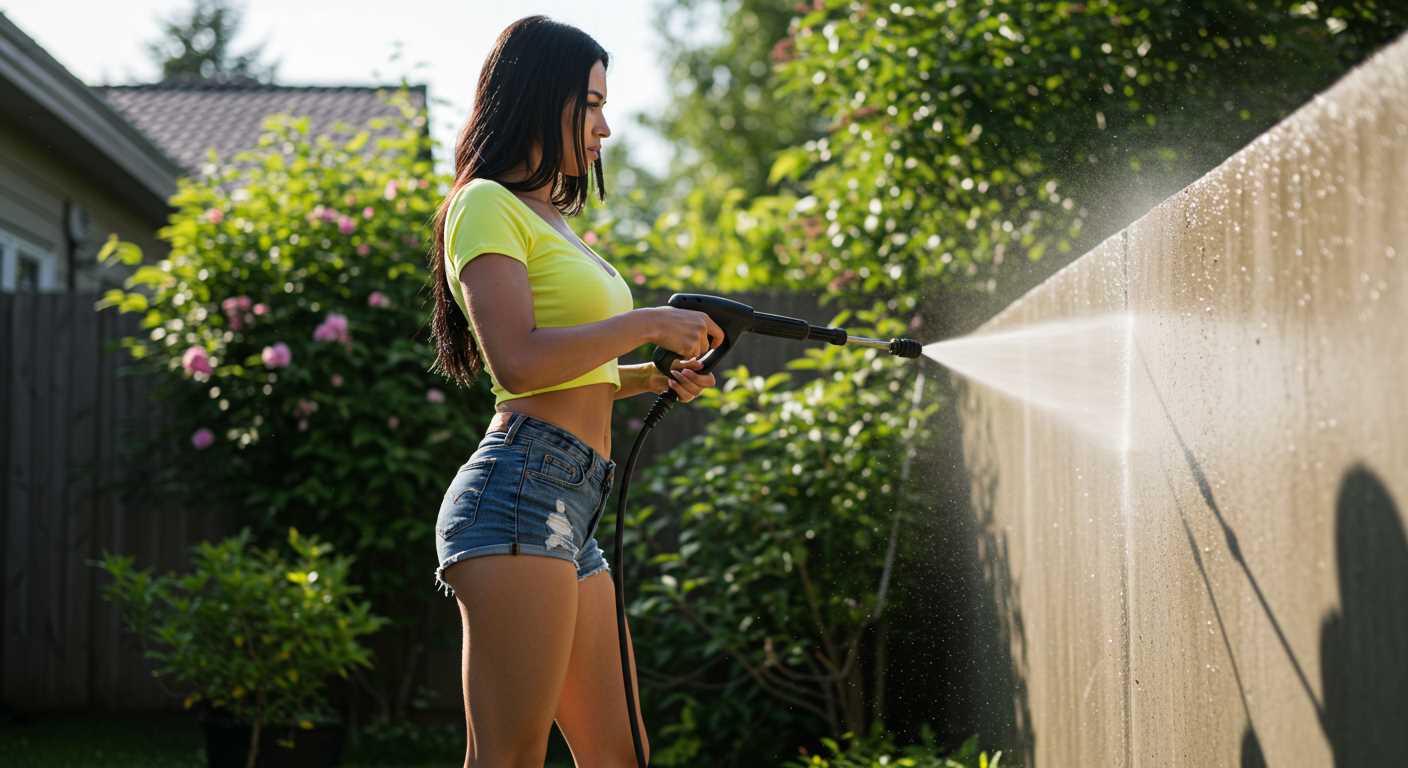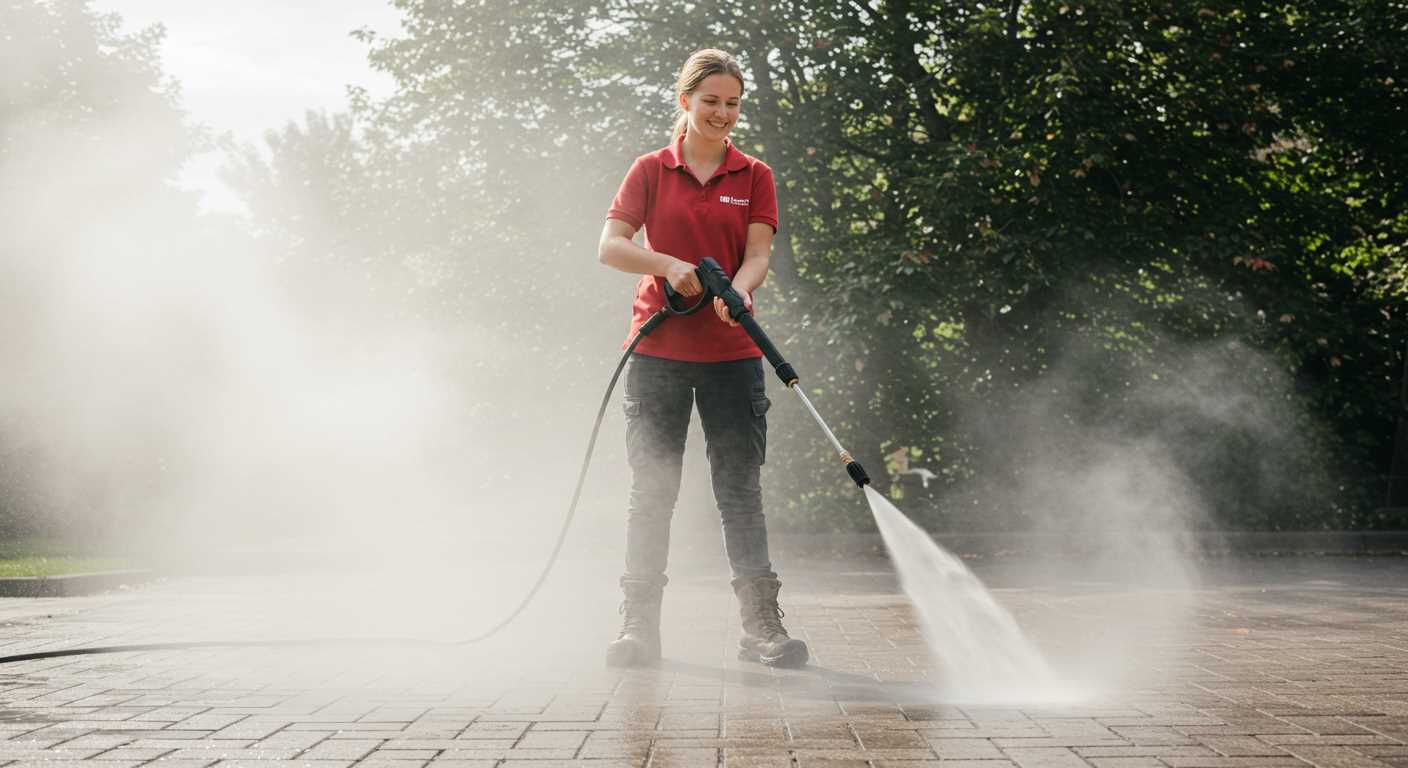

For optimal results, utilise machines equipped with adjustable force settings. This feature allows you to modify the intensity of the water stream based on the surface being cleaned, ensuring both effective cleaning and protection of delicate materials. For instance, a gentle setting is perfect for vehicles, while a higher intensity is suitable for concrete driveways.
When selecting your equipment, keep in mind the specific requirements of your tasks. Some models offer a range of force levels, making them versatile for various applications–from washing pavements to cleaning garden furniture. My experience has shown that devices with adjustable output not only enhance performance but also prolong the lifespan of the machine by preventing unnecessary wear and tear.
Pay attention to additional features that complement this function, such as interchangeable nozzles that further optimise the output. A good strategy is to test different settings on a small, inconspicuous area before proceeding with larger surfaces, helping you determine the best approach for your cleaning tasks.
Understanding Adjustability in Cleaning Equipment
The capability to modify the intensity of the output stream is paramount for efficient cleaning. This feature allows for a diverse range of applications, from delicate surfaces to robust structures. When using equipment designed with this function, always begin at the lowest setting to assess the materials you’re dealing with. Gradually increase the force as needed, ensuring not to cause damage.
Applications and Benefits

This adjustability not only enhances versatility but also optimises water usage. You’ll find that many units allow you to switch between settings seamlessly, accommodating various tasks without changing attachments. Whether tackling grime on vehicles or heavy stains on patios, using the correct setting prevents unnecessary wear and enhances performance. Always refer to the manufacturer’s guidelines for specific recommendations tailored to your model.
Maintenance and Care
<p.Regular checks on the adjustment mechanism ensure it functions correctly. Debris and contaminants can hinder its performance, so clean the nozzle and related components periodically. Lubricate any moving parts as suggested in the user manual to maintain smooth adjustments. Proper maintenance not only extends the lifespan of the equipment but also guarantees optimal functioning when called upon for demanding tasks.
Understanding the Mechanism of Variable Pressure Systems
For optimal performance, it’s crucial to comprehend how the adjustable output systems function within these devices. The core of this mechanism lies in a combination of a pump, nozzle, and control dial that lets users manage the intensity of the water stream.
The pump generates flow, while the nozzle shapes that flow, affecting the water’s force. By modifying the nozzle size or angle, the output can be tailored for various tasks–from gentle rinsing of delicate surfaces to vigorous scrubbing of tough grime.
An integrated control dial often regulates the flow rate, allowing fine-tuning to meet specific cleaning requirements. This feature conserves water and energy while enhancing user control. The ability to switch between settings with ease ensures that each cleaning task is approached with the appropriate force.
Regular maintenance of these components is essential for optimal function. Check the nozzle for clogs and keep the pump lubricated according to the manufacturer’s specifications. This diligence prolongs the lifespan of the equipment and ensures consistent performance.
Understanding the interplay between these elements not only improves cleaning outcomes but also enhances the longevity of the machine. Each user can fully capitalise on the versatility of the equipment, achieving results effectively across a range of surfaces and applications.
How to Adjust Pressure Settings for Different Surfaces
For optimal cleaning results, modify the levels on your machine according to the surface type. Here are precise guidelines for various materials:
- Concrete:
- Use a high setting, typically around 2500-3000 PSI.
- Maintain a distance of 12-18 inches from the surface to prevent damage.
- Wood Decking:
- Select a medium setting, around 1500-2000 PSI.
- Utilise a fan tip nozzle for even coverage.
- Vinyl Siding:
- Adjust to a lower setting, approximately 1300-1600 PSI.
- Keep a distance of 2-3 feet to avoid dislodging panels or causing striping.
- Cars:
- Use a gentle setting around 1200-1500 PSI.
- Employ a wide-angle nozzle to disperse the force evenly.
- Bricks and Stone:
- Enjoy a higher setting, typically 2000-2500 PSI.
- Avoid close proximity; maintain a distance of at least 18 inches.
Always perform a spot test on a small, inconspicuous area to ensure compatibility. Adjust your approach according to individual circumstances, such as dirt level and surface condition. Consider incorporating detergents suitable for specific surfaces to enhance cleaning performance.
By diligently adjusting the force exerted by your machine based on these recommendations, you can achieve superior results while safeguarding the integrity of the surfaces you’re cleaning.
Common Misconceptions About Variable Pressure Cleaning Devices
Many believe that all cleaning units with adjustable output are the same, but this isn’t accurate. Devices vary significantly, and understanding their differences is essential for optimal performance. For instance, some assume that a higher output always translates to better cleaning. While more forceful jets can remove stubborn grime, they can also cause damage to delicate surfaces such as wood or painted finishes.
Another prevalent myth is that these machines allow for effortless adjustment while in use. In reality, some models require users to stop the device to change the settings, which can be cumbersome during a task. Familiarising yourself with the operational specifics is vital for an efficient cleaning process.
Many users also think that a single nozzle can handle all types of tasks with varying intensity levels. However, utilising appropriate attachments for specific jobs is crucial. Certain nozzles are engineered for lighter cleaning, while others excel at more rigorous tasks.
Additionally, there’s a misconception that these units are only beneficial for heavy-duty jobs. In fact, they can be incredibly effective for light tasks too, enhancing time efficiency without compromising safety on less robust surfaces.
Lastly, some people assume they can save money by purchasing a less expensive model with adjustable output, compromising on quality. Investing in a trusted brand often leads to better longevity and superior results.
Benefits of Using Adjustable Force in Cleaning Tasks
Utilising machines with adjustable force allows for tailored cleaning solutions, ensuring optimal results for various surfaces. For instance, delicate materials can be treated with gentleness, which reduces the risk of damage while still achieving cleanliness. I’ve seen firsthand how adjusting the intensity can prevent gouging or deterioration of surfaces like wood or painted finishes.
Saving water is another significant advantage. Lower settings conserve liquid while still delivering satisfactory cleanliness, making it an eco-friendly choice without compromising performance. This efficiency not only benefits the environment but also reduces your water bill.
Flexibility is paramount; implementing a range of levels means you can tackle multiple tasks without needing different machines. I have operated devices that easily transition from cleaning a patio to gently washing a car, streamlining processes and saving time.
Enhanced cleaning effectiveness is evident with these systems. By optimising output, you can eliminate stubborn dirt without extensive scrubbing. It’s remarkable how a simple adjustment can improve cleaning results significantly, especially on textured surfaces where dirt accumulates.
Finally, safety is a key aspect. Reducing intensity mitigates the risk of injuries or accidents. Whether working close to skin-sensitive areas or managing slippery surfaces, a conscious control over the force applied adds an important layer of security during tasks.
Safety Considerations When Adjusting Pressure Levels

Always wear protective eyewear to shield against flying debris when modifying the force emitted by the device. Goggles or safety glasses are essential. Ensure your skin is covered; protective gloves and clothing can prevent injuries from strong jets.
Before altering the settings, turn off the machine and disconnect it from the power source. This simple step can prevent accidental activation when making adjustments. Verify that hoses and fittings are secure; loose connections can lead to unexpected leaks or bursts, risking injury.
Use a low setting on delicate surfaces to assess the impact before transitioning to a stronger setting. This helps gauge how materials react, avoiding potential damage or injury. Always aim away from yourself and bystanders, as the force can kick up debris or cause harm if misdirected.
Keep a safe distance from the surface being cleaned. Direct contact can lead to serious injuries. Be aware of your surroundings, particularly in wet or slippery areas, to avoid falls or accidents while operating the equipment.
Regularly inspect hoses for wear or damage, as compromised lines can pose hazards. Ensure that the cleaning solution used, if any, is suitable for your device and the material being treated, as improper chemicals can lead to negative reactions.
If you are inexperienced or unsure, consult the manufacturer’s guidelines for specifics on settings and safe handling before proceeding. Training resources or tutorials can provide valuable insights into proper practices and safety measures.
Remember, staying informed and cautious is vital for a successful and safe cleaning experience. Proper attention to safety can prevent accidents and promote effective operation of your equipment.
Comparing Fixed Pressure vs. Variable Pressure Models
I’ve spent countless hours comparing fixed and adjustable models, and I can say the latter offers significant advantages. An adjustable system allows versatility in application, enhancing efficiency during cleaning tasks.
Performance Overview

Fixed models maintain a single output, which can be effective for tougher surfaces but may risk damage on more delicate materials. The adjustable version caters to a wider range of surfaces, from tough concrete to painted wood, providing optimal cleaning results without excessive wear.
| Aspect | Fixed Model | Adjustable Model |
|---|---|---|
| Versatility | Limited to specific tasks | Suitable for multiple surfaces |
| Risk of Damage | Higher risk on fragile materials | Minimal risk with settings adjustment |
| Ease of Use | Simple operation | May require learning settings |
| Cleaning Efficiency | Effective but less controlled | Optimised for varied tasks |
Investment Considerations
Choosing an adjustable model can demand a higher upfront cost, but the long-term savings through reduced materials damage and enhanced cleaning frequency often outweigh this. It’s an investment that pays dividends in versatility and effectiveness.
Maintenance Tips for Variable Pressure Washers
Regular upkeep ensures longevity and optimal performance. Here are key steps I recommend:
- Inspect Filter Regularly: Check the water filter at the inlet. Clean or replace it every few months to avoid blockages.
- Check Hoses and Connections: Look for cracks or leaks. Replace damaged hoses immediately to prevent water loss and maintain performance.
- Clean Nozzles Frequently: Clogged nozzles can affect the spray pattern. Use a small pin or needle to clear any debris from the nozzle tip.
- Flush System After Use: After completing your tasks, run clean water through the system to remove detergent residues that may cause buildup.
- Store Properly: During colder months, ensure all water is drained from the machine and store it in a frost-free environment.
- Maintain Oil Levels: If your model has a motor requiring oil, check the levels regularly and change when necessary according to the manufacturer’s instructions.
- Inspect the Pump: Look for any signs of wear and listen for unusual sounds when operating. Address any issues promptly to prevent further damage.
- Follow User Manual Instructions: Always refer to the manufacturer’s guide for specific upkeep recommendations tailored to your unit.
By following these simple yet effective steps, I’ve noticed that devices last longer and deliver consistent results. Regular maintenance is key to avoiding costly repairs and ensuring reliable cleaning performance.
FAQ:
What does variable pressure mean in pressure washers?
Variable pressure in pressure washers refers to the ability of the machine to adjust its water pressure settings. This feature allows users to modify the intensity of the spray depending on the cleaning task at hand. For instance, low pressure can be used for more delicate surfaces, such as car paint or wooden decks, while higher pressure is suitable for tougher jobs like removing grime from concrete driveways. By being able to control the pressure, users can achieve better cleaning results and avoid damaging surfaces.
How does variable pressure work in a pressure washer?
Variable pressure in a pressure washer typically works through a valve or nozzle system that allows the operator to change the flow of water. When the user adjusts the settings, the machine either increases or decreases the amount of water and its pressure. This can be done manually or through a trigger gun on the pressure washer. Many modern models feature a dial or switch for quick adjustments. This flexibility is valuable as it lets users tailor the pressure to specific cleaning tasks, combining high pressure for tough stains and low pressure for more sensitive areas.
What are the benefits of using a pressure washer with variable pressure settings?
The primary benefit of having variable pressure settings in a pressure washer is versatility. Users can apply different levels of pressure depending on the surface type and cleaning requirement. This helps to prevent surface damage, such as stripping paint or creating scratches on softer materials. Additionally, it can lead to more effective cleaning, as the right pressure can help to remove dirt, mould, and other debris more efficiently. Moreover, using lower pressure settings where suitable can save water and energy, making it a more environmentally friendly option.







